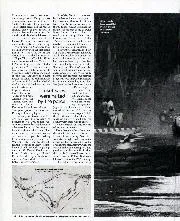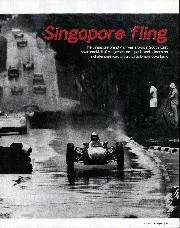Australasian influence was felt immediately when Greg Cusack led in his Brabham BT6. The local aces, however, had fitted long-range tanks for this 60-lapper and assumed the lead when the man from Queanbeyan – of subsequent Mark Webber fame – refuelled.
Cusack eventually spun out while attempting to regain the lead on a track resurfaced at a cost of $75,000 but made slippery by rain, and the win went to the Lotus 22 of Lee Han Seng.
The first Australian win wasn’t secured until 1968 – by Elfin founder Garrie Cooper – but already the presence of Tasman racers had increased the race’s professionalism and competitiveness. Although it retained Formule Libre status, mixing single-seaters with sports cars and even Lotus Cortinas was now passé.

Lawrence races for Ferrari at 1970 Singapore Grand Prix
YouTube
In 1970 Lawrence brought the most exotic racing car yet seen at the peninsula’s tip: the Ferrari 246T with which he and Chris Amon had won Tasman titles.
“The track was very smooth but had a lot going on – fast corners, hairpins, etc – and luckily that Ferrari was pretty nimble,” he says.
“I was battling with my good friend Kevin Bartlett in ‘Yellow Submarine’ [an Alfa Romeo V8-powered single-seater designed and built in England for Alec Mildren’s team by Len Bailey and Alan Mann] when I ran wide at a hairpin and he slipped by.
“He led for a few laps but then his engine exploded.
“All my Singapore wins are right up there in my career – but 1971 is my favourite.
“To even things up cars had been limited to 1600cc [and two valves per cylinder] and there was a big grid as a result.
“I had a problem with the wing on my little Brabham BT29 and dropped down the field, to fourth or fifth, I think, and had to work my way back through.”
Injury denied Lawrence his attempt at making it four in a row, but he returned in 1973 and put his Surtees TS15-Ford Twin Cam on pole.

The original master of Singapore: Graeme Lawrence (left) pictured ahead of the 1971 Australian Grand Prix
Getty Images
Alongside him was the March 722 of Vern Schuppan. The latter had finished runner-up to Max Stewart’s Mildren-Waggott the year before.
”I had crashed in qualifying when something broke in the rear suspension – the car was absolutely brand new,” says Schuppan. “Luckily I hadn’t hit anything too solid and so we were able to cobble something together and I started from the back.
“I was chuffed with that result.”
Schuppan, from Booleroo Centre in South Australia, was hot property at the time, having won Britain’s inaugural Yellow Pages Formula Atlantic title of 1971 at the wheel of a works Palliser and been signed as BRM’s ‘F1 junior’ – he was 29 – for 1972.













